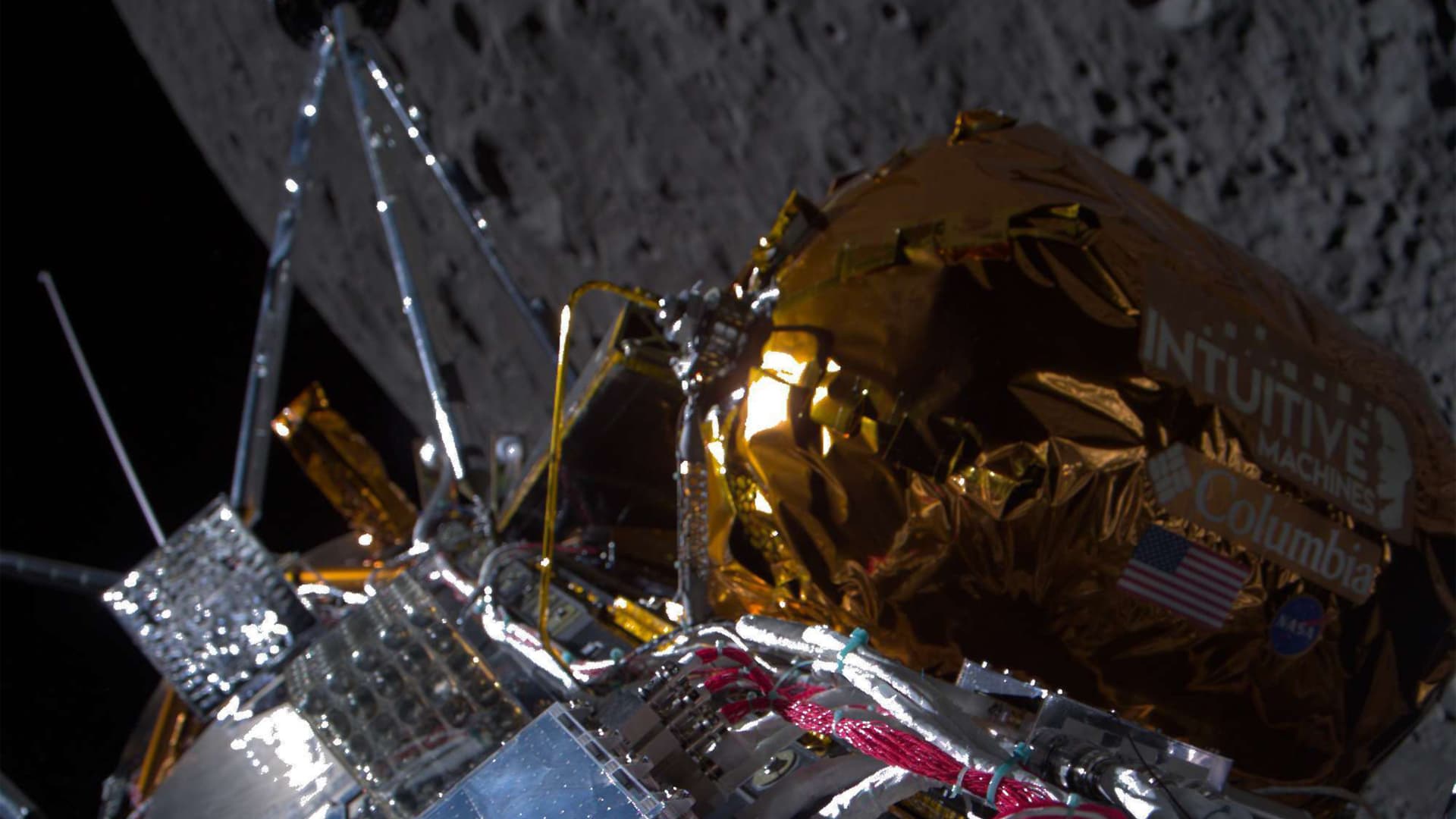The IM-1 lander “Odysseus” in lunar orbit on February 21, 2024.
Intuitive machines
A US company flew to the moon – and entered the history books.
Intuitive machines The IM-1 mission reached the lunar surface Thursday evening, making it the first American moon landing since the Apollo era.
The company’s Nova-C cargo lander, named “Ulysses” after the mythological Greek hero, is the first U.S. spacecraft to land on the lunar surface since 1972. In addition, Intuitive Machines is the first company to land on the moon – government agencies have carried out all successful missions to date.
“We are on the surface, broadcasting. Welcome to the moon,” Intuitive Machines CEO Steve Altemus said from mission control.
As expected, there was a delay between landing and when engineers could judge success.
A few minutes after the expected landing time, Intuitive Machines mission control was still attempting to reestablish communications with the spacecraft to confirm whether it had landed. The company’s mission control finally received a signal and announced that its lander was on the surface.
“What we can confirm without a doubt is that our equipment is on the lunar surface and we are transmitting. “Congratulations, IM-1,” said Tim Crain, CTO and IM-1 Mission Director of Intuitive Machines.
“Odysseus has found his new home,” Crain added.
Two hours after landing, Intuitive Machines said in a statement that “air traffic controllers have confirmed that Odysseus is upright and beginning to send data.”
The company’s stock rose sharply in extended trading on Thursday after falling 11% in regular trading, closing at $8.28 per share.
Intuitive Machines, a Houston, Texas-based company founded in 2013, went public a year ago. After hitting an all-time low in early January, the stock has soared and more than tripled in value, a rally that Wall Street analysts say is fueled by investor excitement over the progress of the IM-1 mission.
Odysseus’ journey
The lander began a series of maneuvers about an hour before landing, beginning with Descent Orbit Insertion.
An illustration of the IM-1 mission with milestones from launch to landing.
Intuitive machines
IM-1 landed in Malapert A crater, about 300 kilometers from the Moon’s south pole. After landing, Intuitive Machines plans to operate Odysseus on the surface for up to seven days.
The mission launched on February 15 on a SpaceX rocket. It carries 12 government and commercial payloads – six of which are destined for NASA under a $118 million contract.
Intuitive Machines and NASA executives show off a model of the company’s Nova-C lunar lander during a presentation on May 31, 2019.
Aubrey Gemignani/NASA
The hexagonal lander is 4.3 meters (or about 14 feet) tall and its legs are 4.6 meters (or about 15 feet) wide, making the spacecraft about the size of an SUV standing on its end.
Sign up here to receive weekly editions of CNBC’s Investing in Space newsletter.
NASA leadership emphasized before launch that “IM-1 is an Intuitive Machines mission. “It’s not a NASA mission.” IM-1 is the second mission under NASA’s Commercial Lunar Payload Services (CLPS) initiative, which aims to bring scientific projects and cargo to the Moon on an increasingly regular basis to support the Artemis to support the agency’s occupation program.
“Today the United States returned to the Moon for the first time in more than half a century. Today, for the first time in human history, a commercial company and an American company launched and led the journey there,” NASA Administrator Bill Nelson said in the livestream
Intuitive Machines’ Nova-C lunar lander is on display at NASA’s Marshall Space Flight Center.
NASA
Lunar geopolitics
IM-1 is also the latest step in a broader geopolitical race to the moon. While Intuitive Machines represents the latest American initiative, other nations – both US rivals and allies – are pouring money into lunar programs.
Last month, Japan became the fifth country to land on the moon, after Russia, the United States, China and India.
Governments and private companies have made more than 50 attempts to land on the moon since the first attempts in the early 1960s, with mixed success, and the track record has remained shaky this century. But that doesn’t deter the modern race for the moon, which is now in full swing.
NASA expects US companies to launch more missions this year, while China plans to launch its next lunar lander in May.
Source link
2024-02-23 01:32:29
www.cnbc.com















